The AMD Ryzen Threadripper 1950X and 1920X Review: CPUs on Steroids
by Ian Cutress on August 10, 2017 9:00 AM ESTCPU Legacy Tests
Our legacy tests represent benchmarks that were once at the height of their time. Some of these are industry standard synthetics, and we have data going back over 10 years. All of the data here has been rerun on Windows 10, and we plan to go back several generations of components to see how performance has evolved.
All of our benchmark results can also be found in our benchmark engine, Bench.
3D Particle Movement v1
3DPM is a self-penned benchmark, taking basic 3D movement algorithms used in Brownian Motion simulations and testing them for speed. High floating point performance, MHz and IPC wins in the single thread version, whereas the multithread version has to handle the threads and loves more cores. This is the original version, written in the style of a typical non-computer science student coding up an algorithm for their theoretical problem, and comes without any non-obvious optimizations not already performed by the compiler, such as false sharing.
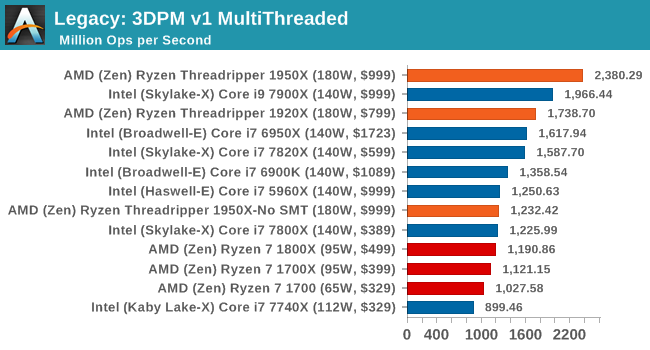
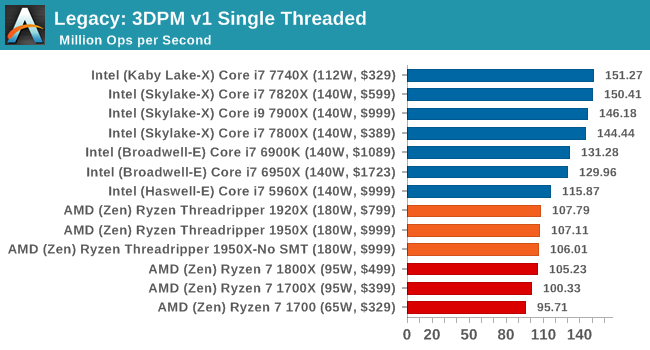
CineBench 11.5 and 10
Cinebench is a widely known benchmarking tool for measuring performance relative to MAXON's animation software Cinema 4D. Cinebench has been optimized over a decade and focuses on purely CPU horsepower, meaning if there is a discrepancy in pure throughput characteristics, Cinebench is likely to show that discrepancy. Arguably other software doesn't make use of all the tools available, so the real world relevance might purely be academic, but given our large database of data for Cinebench it seems difficult to ignore a small five minute test. We run the modern version 15 in this test, as well as the older 11.5 and 10 due to our back data.
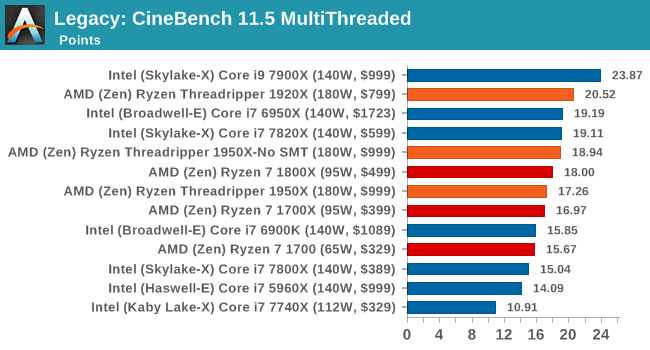
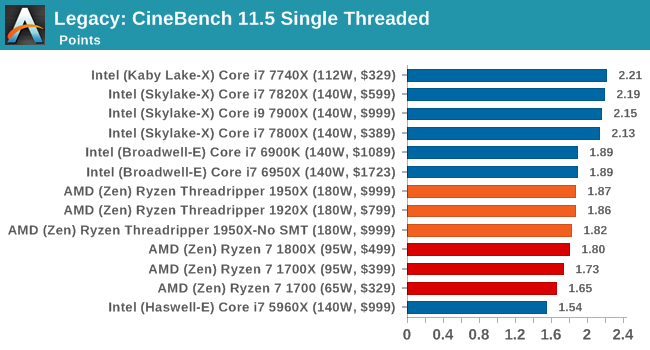
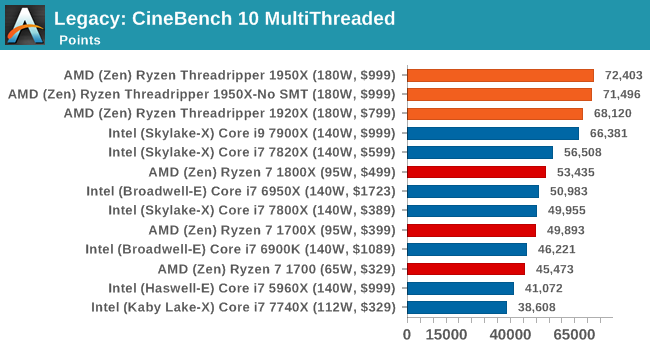
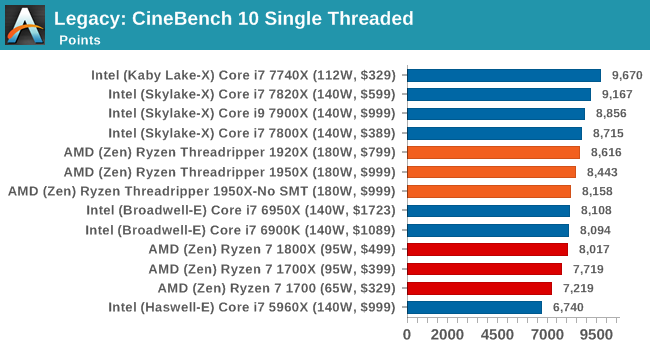
x264 HD 3.0
Similarly, the x264 HD 3.0 package we use here is also kept for historic regressional data. The latest version is 5.0.1, and encodes a 1080p video clip into a high-quality x264 file. Version 3.0 only performs the same test on a 720p file, and in most circumstances the software performance hits its limit on high-end processors, but still works well for mainstream and low-end. Also, this version only takes a few minutes, whereas the latest can take over 90 minutes to run.
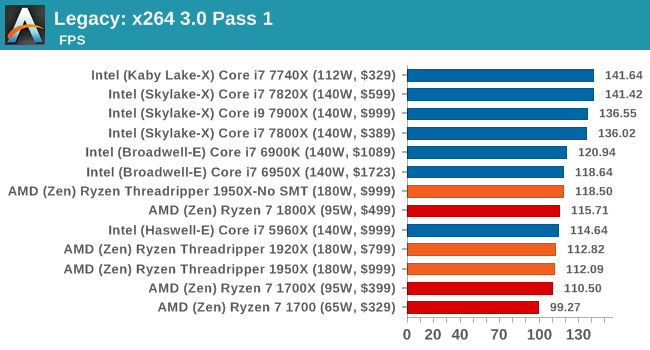
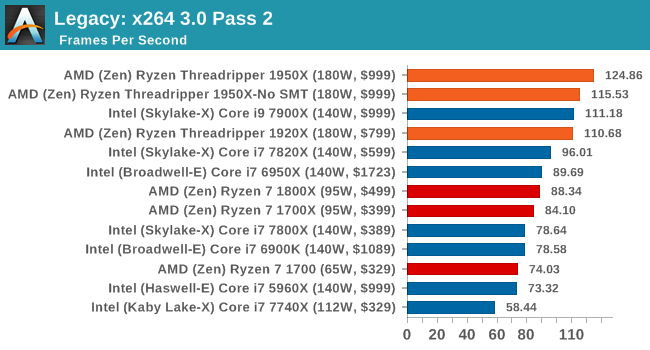
The 1950X: the first CPU to score higher on the 2nd pass of this test than it does on the first pass.










347 Comments
View All Comments
Kjella - Thursday, August 10, 2017 - link
In the not so distant past - like last year - you'd have to pay Intel some seriously overpriced HEDT money for 6+ cores. Ryzen gave us 8 cores and most games can't even use that. ThreadRipper is a kick-ass processor in the workstation market. Why anyone would consider it for gaming I have no idea. It's giving you tons of PCIe lanes just as AMD is downplaying CF with Vega, nVidia has offically dropped 3-way/4-way support, even 2-way CF/SLI has been a hit-and-miss experience. I went from a dual card setup to a single 1080 Ti, don't think I'll ever do multi-GPU again.tamalero - Thursday, August 10, 2017 - link
Probably their target is for those systems that have tons of cards with SATA RAID ports or PCI-E accelerators like AMD's or Nvidia's?mapesdhs - Thursday, August 10, 2017 - link
And then there's GPU acceleration for rendering (eg. CUDA) where the SLI/CF modes are not needed at all. Here's my old X79 CUDA box with quad 900MHz GTX 580 3GB:http://www.sgidepot.co.uk/misc/3930K_quad580_13.jp...
I recall someone who does quantum chemistry saying they make significant use of multiple GPUs, and check out the OctaneBench CUDA test, the top spot has eleven 1080 Tis. :D (PCIe splitter boxes)
GreenMeters - Thursday, August 10, 2017 - link
There is no such thing as SHED. Ryzen is a traditional desktop part. That it raises the bar in that segment compared to Intel's offering is a good thing--a significant performance and feature boost that we haven't seen in years. Threadripper is a HEDT part. That it raises the bar in that segment compared to Intel's offering is a good thing--a significant performance and feature boost that we haven't seen in years.Ian Cutress - Thursday, August 10, 2017 - link
Ryzen 7 was set as a HEDT directly against Intel's HEDT competition. This is a new socket and a new set over and above that, and not to mention that Intel will be offering its HCC die on a consumer platform for the first time, increasing the consumer core count by 8 in one generation which has never happened before. If what used to be HEDT is still HEDT, then this is a step above.Plus, AMD call it something like UHED internally. I prefer SHED.
FreckledTrout - Thursday, August 10, 2017 - link
I think AMD has the better division of what is and isn't HEDT. Going forward Intel really should follow suite and make it 8+ cores to get into the HEDT lineup as what they have done this go around is just confusing and a bit goofy.ajoy39 - Thursday, August 10, 2017 - link
Small nitpick but"AMD could easily make those two ‘dead’ silicon packages into ‘real’ silicon packages, and offer 32 cores"
That's exactly what the, already announced, EPYC parts are doing is it not?
Great review otherwise, these parts are intriguing but I don't personally have a workload that would suit them. Excited to see what sort of innovation this brings about though, about time Intel had some competition at this end of the market.
Dr. Swag - Thursday, August 10, 2017 - link
I assume they're referring to putting 32 cores on TR4mapesdhs - Thursday, August 10, 2017 - link
Presumably a relevant difference being that such a 32c TR would have the use of all of its I/O connections, instead of some of them used to connect to other EPYC units. OTOH, with a 32c TR, how the heck could mbd vendors cram enough RAM slots on a board to feed the 8 channels? Either that or stick with 8 slots and just fiddle around somehow so that the channel connections match the core count in a suitable manner, eg. one per channel for 32c, 2 per channel for 16c, etc.Who knows whether AMD would ever release a full 32c TR for TR4 socket, but at least the option is there I suppose if enough people buy it would happily go for a 32c part (depends on the task).
smilingcrow - Thursday, August 10, 2017 - link
Considering the TDP with just a 16C chip to go 32C would hit the clock speeds badly unless they were able to keep the turbo speeds when ONLY 16 or less of the cores are loaded?The 32C server parts have much lower max turbo speeds seemingly when less loaded.